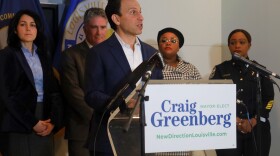In the United States, one in every eight police officers is a woman.
But in Kentucky, that share is much lower — just one in every 15.
Studies show that female officers use force less often than male officers, and there’s evidence that public trust and police outcomes improve when a department looks more like the community it serves.
But in Kentucky, the law enforcement gender gap has actually gotten worse over the last decade, even as more women entered law enforcement nationally.
Interviews with current and former police officers, police chiefs, and researchers indicate Kentucky might foster a particularly inhospitable environment for female officers: low pay insufficient for child care, a large number of small, rural departments and a police culture described by many as a “boys club.”
“Some agencies might be very welcoming, and create that welcoming environment,” said Cindy Shain, a former Louisville police officer who is now director of the Southern Police Institute. “Others just don't…They don't find it terribly important to change some of the issues that really do confront women and why they don't come in.”
In 2008, around 7.1% of law enforcement officers in Kentucky were women, according to data from the Kentucky State Police. That year, 11.9% of officers nationally were women, according to FBI data.
In 2018, the last year the state police released this data, the percentage of female officers declined to 6.6%, even as the national rate rose to 12.6%.
The data didn’t identify the race of the officers or include any gender identities beyond male or female.
Nearly half of all the state’s female law enforcement officers work in Jefferson or Fayette counties, the largest population centers.
A majority of law enforcement agencies had no female officers in either 2008 or 2018. That’s nearly 230 agencies policing cities, towns, counties and schools.
One of the starkest disparities can be found in the Kentucky State Police. The total number of KSP officers grew 12% over the last decade, but female KSP officers actually dropped 27% over that time, according to the data.
In 2018, male KSP officers outnumbered women by roughly 46 to 1.
In a statement, a spokesperson for KSP said the agency’s leadership “strongly believes in diversifying the recruitment pool of personnel at all levels” and “is dedicated to the recruitment of all qualified candidates regardless of sex or race.”
Many Women Balance Police Work And Child Care
When Sandy Joslyn joined the Paducah Police Department in the early 1980s, she knew she was an anomaly. There was only one other woman on the force, and, as people liked to remind her, the only woman before that hadn’t even made it out of the academy.
“They didn’t make it easy for us,” she said. “There was a lot of officers that didn’t want females there. There was a lot of things they put me through to break me, so I would leave.”
They didn’t make uniforms for women, so her bulletproof vest fit her “like a saucer.” She had to sit on phone books in her squad car so she could see out of the windshield. Her male colleagues would send her on pointless middle-of-the-night errands.
“I’d never complain,” she said. “Eventually they realized I was there to stay.”
Joslyn tested into criminal investigations and rose through the ranks to become chief. But even as she gained the respect of her colleagues, she continued to face challenges they didn’t. She married and had two children, which she said was often a struggle to balance with her demanding job.
“I was trying to work a suicide or homicide...and I’d be scraping someone’s brains off the ceiling,” she said. “And then two hours later, I’d be making mac and cheese and doing algebra with my kids.”
Women continue to assume the vast majority of child-rearing responsibility in the United States, and the issue is particularly challenging for female officers in Kentucky, where pay is low compared to the cost of child care. Police officers often work late-night or early-morning shifts, and young officers get stuck with harder work hours when scheduling is governed by seniority.
The average entry-level officer salary in Kentucky was $33,492 in 2018, according to data from the state Department of Criminal Justice Training. Federal data show Kentucky police officers are the ninth-lowest paid in the U.S.
“If you don’t have a support system there that can help you with child care, policing is not it for you,” said Jill Stulz, a detective with the Fort Mitchell Police Department and the president of the Kentucky Women’s Law Enforcement Network.
Stulz is a single mother of two young children, and she knows mothers who chose not to have additional kids — or quit their jobs — because they were treated so poorly by their departments when they had their first child.
“They’re like, ‘Why am I going to work to pay somebody else to raise my kids when I could just leave and raise them myself?’ I don’t blame them at all.”
In 2014, two police officers in Florence, Ky., became pregnant and asked to switch to light duty. The Florence Police Department denied their request and required them to take leaves of absence instead — while granting male officers’ requests for light duty.
Officers Lyndi Trischler and Samantha Riley sued the city, resulting in a consent decree with the federal Department of Justice. The city agreed to rewrite its policies to better accommodate pregnant employees. This lawsuit led Kentucky to pass the Pregnant Workers Act in 2019.
Many officers, including Joslyn from the Paducah Police, said their experience as a woman and a mother makes them better police officers. She considers herself a peacemaker.
“Women are better de-escalators. They talk people down,” Joslyn said.
Studies show female officers are significantly less likely to use excessive force. Higher shares of women in law enforcement also correlate with declines in intimate partner homicide rates and rates of repeated domestic abuse.
But the profession’s reputation as masculine prevails.
Heather Childress, police chief in Horse Cave, thinks of herself as the “mom” of her small, otherwise all-male department. She routinely finds herself using what she calls her “mom voice” to command authority with citizens.
Childress said women have to work even harder to prove themselves to their male colleagues and to the public. She wants women to be held to the same standard as men in the hiring process.
“If you’re out in a fight for your life on the street, no one’s going to say, ‘Oh wait, you’re a girl, let me back down a little,’ ” Childress said. “You’re going to have to run just as fast to catch somebody, you’re going to fight just as hard as a man. You’re going to have to do all the same things.”
Some researchers, though, emphasize there’s a lack of evidence that strength correlates with good policing. The mere perception of physical strength as a prerequisite deters some women interested in law enforcement careers.
“An entrance exam for a profession should actually be indicative of what predicts success in that professional area,” said Cara Rabe-Hemp, a professor at Illinois State University and an expert on gender and policing. “Tests that focus on upper body strength physiologically disadvantage the female form...If upper body strength isn’t predictive of successful policing, that’s a barrier.”
Recruitment Struggles
Nationally, recruiting female officers remains a major challenge because there’s still a societal expectation that women won’t do this work, said Anne Li Kringen, a former police officer and University of New Haven professor of criminal justice.
“We don’t lose women in the background checks,” Kringen said. “We lose them all in the beginning in self-selection out of the process.”
That’s been a major challenge for the Jefferson County Sheriff’s Office, where spokesperson Carl Yates said just 21 women are on the force.
“We would love to recruit more women, and especially right now, more people of color,” Yates said. “But it's very difficult, especially right now with the climate of the country, to do that. People are having second thoughts about getting into law enforcement.”
Yates says a lot of their deputies are assigned to low-risk jobs with regular hours, like courthouse security, which might be appealing to working mothers. But the agency is hamstrung by low pay compared to other agencies.
“We don't have a lot of people leaving because they're dissatisfied there. They leave because they got a better deal somewhere,” Yates said.
JCSO lost 10 female officers between 2008 and 2018 — the largest decline of any agency in raw numbers, though it remains above the state average for the proportion of female officers.
Yates said 72 percent of JCSO’s workforce is “laterals,” or officers who have retired from other departments before coming to work for the sheriff’s office — so much of their recruitment pool is whoever other agencies recruited more than 20 years ago.
Still An Uphill Battle
Shain, of the Southern Police Institute, said female officers are particularly sparse at small police departments, which make up the majority of Kentucky agencies.
In Kentucky, just 7% of small agencies — those with fewer than 10 officers — had a woman on the force in 2018.
In November, following months of protests in Louisville and throughout the country over police killings of Black people, Gov. Andy Beshear said it’s imperative law enforcement “looks more like Kentucky” and its diversity of race, gender and religion. Beshear said he would "put dollars behind that" in his proposed state budget.
But the most recent report with statistics from 2019 no longer includes information on officer gender. KSP spokesperson Billy Gregory said the report now discloses information that’s required by statute. “What is no longer listed was additional information that required additional resources, research and outside agency partnerships,” Gregory said.
Reformers are urging police agencies to target their recruitment at hiring women and people of color. More broadly, they want police leadership to reconsider hiring criteria such as upper-body-strength fitness tests, which critics charge to be discriminatory against the female body.
Shain of the Southern Police Institute acknowledges that it remains an uphill battle to get more women represented in law enforcement in Kentucky.
“I used to think, when I first entered policing, we’d enter and really make a difference,” said Shain. “I think we’ve really made a difference for the community. But I don’t know how much we’ve made a difference in being able to change the structure of policing as an organization.”





